 People are often surprised to learn that Land or Terrestrial Hermit Crabs engage in complex social behaviors, are capable of communicating via “chirps” and, with proper care, may live for over 20 years. I’ve had the pleasure of working with them at home, in zoos and the wild, and have even kept the massive, awe-inspiring Coconut Crab. Please read on to learn about their care and natural history, and be sure to post your own thoughts and experiences.
People are often surprised to learn that Land or Terrestrial Hermit Crabs engage in complex social behaviors, are capable of communicating via “chirps” and, with proper care, may live for over 20 years. I’ve had the pleasure of working with them at home, in zoos and the wild, and have even kept the massive, awe-inspiring Coconut Crab. Please read on to learn about their care and natural history, and be sure to post your own thoughts and experiences.
Hermit Crab Natural History
The Purple-Pincher or Caribbean Hermit Crab (Coenobita clypeatus) is the most common pet trade species. It ranges throughout the Caribbean, reaching as far north as Florida and Bermuda.
Some populations live at altitudes of over 3,000 feet, but females return to the sea, usually in one massive migration, to spawn. The larvae, or zoea, float about with plankton for 2 months, after which they take up life on land.
Land Hermit Crabs carry about the discarded shells of other creatures as shelters, and must find larger shells as they grow. Recently it was discovered that they will line up in size order behind an empty shell – as the first crab (the largest) moves into its new home, others in line will “trade up” for the shell of the crab immediately in front of them! Please see the article below for details.
Ecuadorian Hermit Crabs (Coenobita compressus) and several Asian species also appear in the pet trade. The Coconut Crab (Birgus latro) is sometimes kept within its native range.
Crab Behavior
Land Hermit Crabs are nocturnal, but pets often emerge to feed by day. When established in a properly-designed terrarium, they will be quite active and exhibit many interesting behaviors.
Handling is stressful to Hermit Crabs, including long-term pets. They can be grasped by the back of the shell, but often can reach this area with their claw. Large individuals can administer a painful pinch, and I’d bet that the Coconut Crab can break fingers!
Housing
Setting up the Terrarium
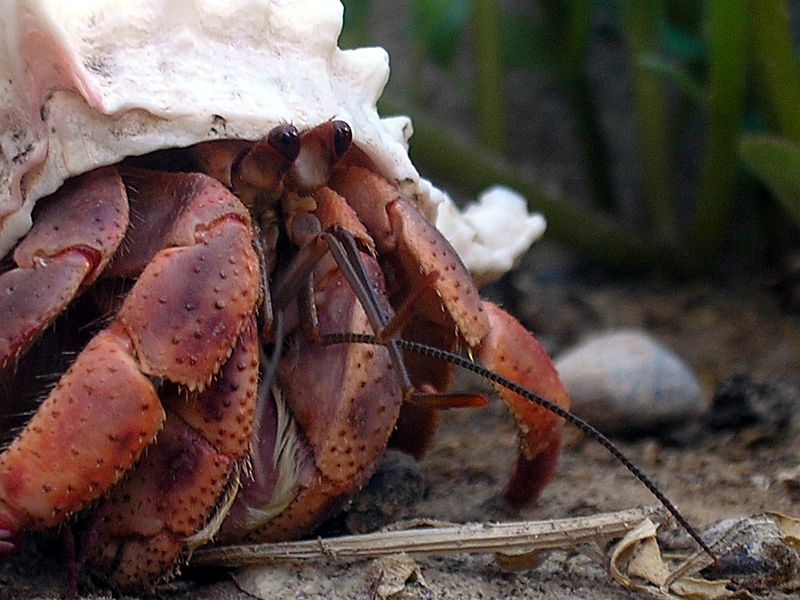 A 10 gallon aquarium will accommodate 4-5 small crabs. Large, naturalistic terrariums will allow the crabs to exhibit a wider range of behaviors than will small, bare enclosures.
A 10 gallon aquarium will accommodate 4-5 small crabs. Large, naturalistic terrariums will allow the crabs to exhibit a wider range of behaviors than will small, bare enclosures.
Driftwood, cholla wood, reptile caves, up-ended clay flower pots and similar furnishings will add greatly to your crabs’ quality of life. Empty shells should always be available.
A molting tank should be set up if you keep more than one crab. Land Hermit Crabs are soft and defenseless after molting, and will be eaten by their former friends. Check daily for signs of an impending molt – digging, remaining below ground and listlessness are typical. Molting crabs should be isolated (please write in for information).
Substrate
A mix of calcium sand and coconut husk makes an ideal substrate. The substrate should be at least 6 inches deep and mixed with enough water so that is just sticks together when squeezed.
Light
Red/black reptile night bulbs will allow you to watch your crabs after dark. A 12-hour day/12 -hour night cycle is ideal.
Heat
A temperature range of 75-82 F should be maintained. These tropical creatures will not survive long term exposure to temperatures below 72 F.
Incandescent bulbs or red/black reptile night bulbs can be used to heat the terrarium. Ceramic reptile heaters are useful at night. Reptile heat pads can be used to warm the substrate, but these do little to heat the air. All of the above will dry out the substrate, so it is important to monitor the humidity.
Humidity
Land Hermit Crabs possess unique gills that enable them to breathe air. A humidity level of 70-80% is vital to survival, as the gills must be kept moist in order to function. A simple humidity meter should be used. Humidity can be increased by misting, adding water to the substrate and partially covering the terrarium’s lid with plastic.
Companions
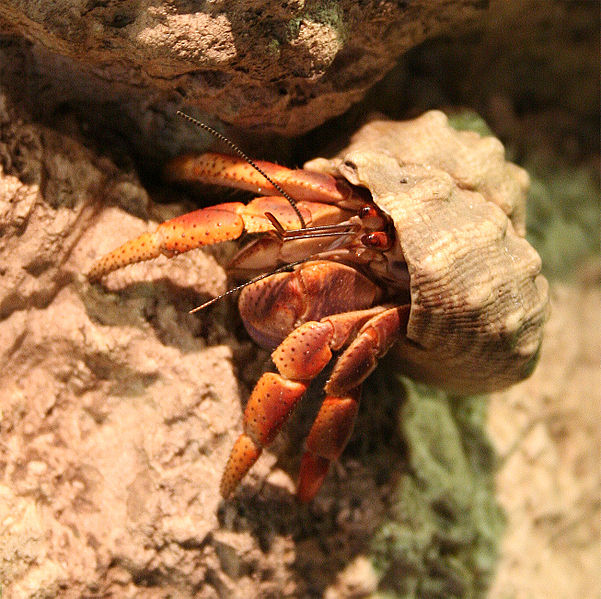 Land Hermit Crabs are social animals, but dominant individuals may prevent others from feeding properly. Crabs that are molting must be isolated or they will be attacked (please see above). A variety of empty shells must be available, or fighting and “evictions” will ensue.
Land Hermit Crabs are social animals, but dominant individuals may prevent others from feeding properly. Crabs that are molting must be isolated or they will be attacked (please see above). A variety of empty shells must be available, or fighting and “evictions” will ensue.
Feeding
Wild Hermit Crabs eat just about everything – animal, vegetable and mineral – that they encounter. Captives will not thrive without a varied, high-calcium diet.
Commercial Hermit Crab pellets may be used as a portion of the diet. The following foods should be included regularly: fresh shrimp and fish, fruits and vegetables (carrot may help to maintain coloration), hard-boiled egg, nuts, seeds, dry seaweed (sold as Nori), oatmeal, fish flakes, canned crickets, and freeze-dried fish foods (krill, plankton, brine shrimp, etc.). They also relish decaying wood and leaf litter; these should be collected from pesticide-free areas.
Cuttlebone bits and reptile calcium powder should be mixed into your crabs’ food.
Often overlooked is their need for a bowl of marine water; marine aquarium salt mixes, not table salt, should be used. Soaking in this water will provide the crabs with essential minerals not present in their food. Fresh de-chlorinated water should also be available. Bowls should be filled to half the height of the smallest crab and be easily-exited, as Land Hermit Crabs drown easily.
A wide variety of specialty cages, supplies and foods are now available. Please post any questions or comments you may have regarding their use.
The Coconut Crab (Birgus latro), aka The Robber Crab
With a 16 inch body supported by legs spanning 3 feet, this impressive beast (described as “monstrous” by Charles Darwin!) is the world’s largest land-dwelling arthropod. I first saw them at the Cincinnati Zoo Insectarium in the early 1980’s, and was instantly hooked. After a prolonged search, I obtained 2 adults for an exhibit at the Bronx Zoo. Unfortunately, they did not fare very well, and this seems to be a common experience (wild individuals may attain age 40+). Losses are especially high during the month-long molt, which is spent underground.
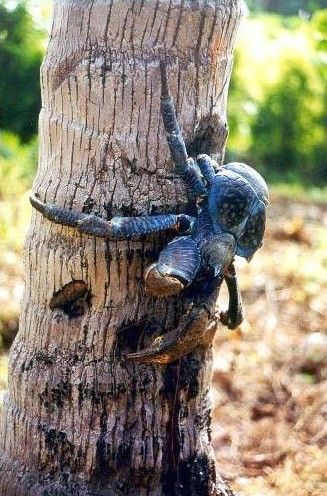 The Coconut Crab ranges throughout the Indian and Western Pacific Oceans. A co-worker of mine found them raiding his garbage cans on Guam; his experiences with refuse-feeding coatis and coyotes elsewhere in no way prepared him for that!
The Coconut Crab ranges throughout the Indian and Western Pacific Oceans. A co-worker of mine found them raiding his garbage cans on Guam; his experiences with refuse-feeding coatis and coyotes elsewhere in no way prepared him for that!
Coconuts may be their best-known food, but form only a small portion of the diet. Generally, the crabs pinch nuts from coconut palms, and then feast on the broken remains below. A crab may also pull back the husk from an unbroken coconut and then pierce the soft “eye” with one of its pointed legs. The rest of the diet is as varied as that of their smaller relatives.
Coconut Crabs are declining in portions of their range. Threatened by food trade collection and predation by introduced rats, ants, pigs and monkeys, they have been extirpated from Australia and Madagascar.
Further Reading
Hermit Crab “Shell Trading” Behavior
Natural History of Land Hermit Crabs on Bermuda
Coconut Crab image referenced from wikipedia and originally posted by Anne Sheppard
 That Reptile Blog – Reptile, Amphibian and Exotic Pet Care and Information
That Reptile Blog – Reptile, Amphibian and Exotic Pet Care and Information


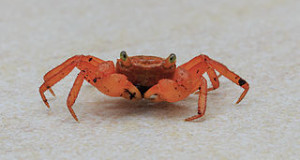
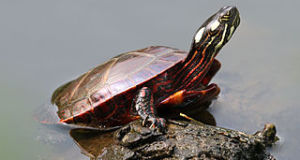
Thanks for posting. I currently have a hermit crab setup with two in there. i notice one has been digging an aweful lot and I am glad to know that it may be a pre molt. They are pretty big land hermit crabs and I do not know what size shells to get.
Hi Ariel,
Thanks for the feedback;
Be sure that the substrate is deep enough to allow for burrowing, and provide a few shells that are slightly larger (internally) than the current shell, Best, Frank
Thanks for the share. I think if anyone purchase shells, the shell should be a size bigger than the previous size. But much bigger size will not be beneficial, as the crabs always tries to find the previous shell’s feel in the later ones. So much bigger or designed shells will not provide any added advantage according to me.
Hi,
Thanks for your input. Yes, always best to provide as wide a variety as possible; in the wild, I’ve seen them make due with ill-fitting shells (and discarded plastic,etc!) but in captivity its best to let them try out a few when changing shells. Best, Frank
I’ve seen coconut crabs at Japanese pet stores and they truly are a sight to behold!
I think the housing would require too much effort, but they do seem like an interesting pet to keep 🙂
Hi Paul,
Thanks for your note. Since childhood, I’d been fascinated by the interest Japanese people show in invertebrates (being bug-crazy in the Bronx, way back then, was not “typical”, shall we say!). I eventually managed to spend some time there, after making contacts through the zoo field. I was astonished at the insect exhibits in zoos, pet trade interest and so on (public aquariums, and pet trade fishes, were also amazing). I never ran across coconut crabs…thanks for letting me know. Do you happen to remember the price range…I recall that we (Bx Zoo) paid $600.00 each in 1985.
Did you have a chance to visit any insect exhibits, i.e. at the Tama Zoo, or aquariums? I can’t wait to go back.
Best regards, Frank
Yeah, Japan does have a big fascination with insects. Two weeks ago I went to a Reptile/Insect show in Tokyo and it was definitely interesting 🙂
I’ll check the price next time I happen by that pet store. It’s a very large one in Yokohama that carries a range of exotic pets which change regularly. If I were rich I’d pick up the armadillo they’re selling for $3,000. They also have a miniature pig and small monkey. Have also seen prairie dogs and meerkats on sale as well. Very startling array of pets for a Minnesotan like me to encounter.
I think one of most fun bug exhibits I’ve seen was in Penang, Malaysia at the Butterfly Farm. Went there in August, had a blast.
Hi Paul,
Thanks very much for the note, you’ve ignited my desire to return. I visited an impressive aquarium in Yokohama about 5 years ago, name escapes me now…entry was up a long ramp, then you worked your way down, I believe. Was especially surprised b some of the deep sea inverts they were able to keep.
My Mom was fascinated by Japan when I was a child…odd, as she was WWII generation and we lived in the Bron, sans any Japanese influence. But she had me join the Japan Society in Manhattan, learned a bit of the language and so on. Once I learned about their interest in insects, my interests really took off. Even as late as the 80’s, when I was setting up invert ehibits for the B Zoo, the best sources of books and info were in Japan.
I’ve worked with armadillos…very interesting beasts, and they seem to draw invert-herp enthusiasts I’ve noticed. Always surprised by the value of animals in the trade; 9 banded armadillos are feral in the SE USA, garden pests in many places! I recall many years ago a hep dealer I worked for shipped some leopard frogs (used as lab animals at the time) to Japan, as a freebie along with animals that had been ordered. The dealer asked as to sens as many as possible, and offered to pay very well…
Please keep me posted when you have time..I’m planning a few related articles and would appreciate being able to use some of your observations. Are you living there permanently? If so’ I’ll touch base when I visit. Best, Frank
That’s quite interesting, didn’t even know there were Japan Societies!
I’ll be starting a reptile blog which is focused on providing locations of pet stores and event info in English for those who live in Asia. Starting out first with just Japan but I would like to expand later.
If you want to keep in touch you can add me on Facebook: http://www.facebook.com/paul.franz.925
Hi Paul,
Thanks…very good to hear, I wish you well. I’ll keep tabs on Facebook, but I don;t get a chance to do so all that often. I’m on FB at http://www.facebook.com/frank.indiviglio.9, my email is findiviglio@thatpetplace.com. If you have a chance, please send an email or post a note on any blog article so that other readers can benefit as well, thanks.
Japan Society, Nippon Club (business oriented) and the Asia Society have long been in Manhattan, along with many smaller institutions. Although a grew up a “world” away culturally (in the Bronx), a quick train ride took me to all, as well as the Am Museum of Nat History, etc…I was very fortunate, as my family encouraged that as well.
Just rec’d a note that a fish importer in Miami is selling Australian Lungfish; have you seen them in aquariums or pet trade? I saw them at several zoos/aquariums in Japan..unbelievable, easy to picture one crawling out of the water and starting down the path to a terrestrial existence. I was surprised to see them munching on chopped plantains; the African/SA species I’ve kept were strict carnivores, but then again they are very different animals… Enjoy, Best, Frank
Hi! We are in need of your experience and guidance. My friend have sheltered 3 juvenile coconut crabs yesterday. We are putting up a terrarium for them. We would appreciate it if you share your thoughts and expertise on how we may be able to provide for the amazing creatures. Thank you very much!
Hello Gail,
Their general care is a s described for other hermit crabs, but need temperatures of 75-85F and moist substrate deep enough to burrow into..especially important at molting time,. A bowl od fresh and a bowl. of marine water should be available. They eat a wide variety of fruits, vegetables and need protein sources as well…fish with bones, whole shrimp, moistened dog/cat chow or commercial hermit crab foods, etc. They often fight, and at molting time cagemates often find and consume molting animals before their carapace hardens..best kept singly.
please let me know if you need more info, frank
Hi, Frank! Merry After Christmas! Now that the rush is over, I have a few specific questions about coconut crab husbandry. Our zoo acquired one which was found walking down a local boulevard. They aren’t native to Hawaii and it is illegal for private individuals to keep them here, so the state Department of Agriculture was kind enough to turn it over to us.
How deep should their water dishes be? I’ve heard they can drown if the dishes are too deep, but don’t know how to judge “too deep” in relation to crab size. Also, being just off Waikiki, we have access to natural sea water. Pluses would be a more natural and possibly more complete salt water, minuses would be the possibility of introducing disease or parasites not found in a marine aquarium mix. Thoughts?
On moulting, is there a way to tell before they are ready to molt? I’ve read that it’s seasonal and once a year for adults, but the seasons vary for males and females. Do you know what depth of substrate is necessary in relation to crab size (of course, larger crabs would require deeper substrate. . . ). Also, are they vertical or horizontal burrowers? In quarantine it will have a large stock tub filled with deeper substrate for burrowing, but once it’s released and we can design an exhibit it could have a hill or simulated roots, giving it the opportunity to burrow in a more horizontal fashion.
Thanks for any info you can provide!
Hi Rebecca<
Thanks…Merry Christmas and A happy, healthy NEW YEAR TO YOU ALSO.
I'm here in NYC in December, and you need only walk a few feet for fresh sea water on Waikiki?..sounds like you should be giving me advice on where to live!!
But seriously, I've used sea water from NYC area, as do some of our public aquariums (some treatment, but many inverts survive and populate exhibits), w/o incident…parasites and such seem fairly specific, etc. But zoo vets generally complain, and in any event artificial mixes are very reliable today and have been used for this and other crabs. Coconut crabs may not rely upon soaking as much as do smaller species, but best to provide as insurance. I use water about half the depth of a crab's body..they can drown, but in a rough sided or sloping container will climb out easily.
I wrote to a contact formerly at the Cincinnati Zoo, where they had a bit more luck than I, but have yet to hear back. Ours dug down 2 feet or more, in a cattle trough, but each crab expired during the molt. I don't have a good handle on burrow details…seemed to go almost straight down, but given their habitat they likely can adjust details; humidity, and space to actually molt (large chamber a burrow's end) seem to be the most impt factors (as well as enough calcium stores, I would guess). This IZ Yearbook article seems to be right on point….London Zoo has a long history with inverts; I do not have a copy of the full article…would enjoy seeing it if you are able to obtain.
Sorry I could not be of more help, I’ll get back if I hear from Cin. Zoo. Please keep me posted, interested to hear how all goes,
What do you work with in general?
Best, Frank
Hi, Frank-
In general I work with herps, have been for over 20 years now, but there’s been a smattering of inverts and other critters that have found their way into my care over the years, and amphibs are a special passion of mine. I must admit, the coconut crab is a new challenge!
Thanks for all the crab inf.! We’re trying to chase down the IZ Yearbook article, if we get it I’ll arrange to get a copy to you. Our curator also tracked down someone on island who did some research on them and he’s arranged to come out on Tuesday and take a look at the setup and possibly sex the crab for us. I’ll keep you updated.
Hope the New York winter is being kind to you!
Aloha,
Rebecca
Same here…herps, esp amphibs, salamanders a special interest, but inverts always a passion; was lucky enough to have worked in all Bronx Zoo depts and buildings before getting into the reptile dept…here inverts are always given to the herp folks as well. Glad you have someone on sight, looking forward to hearing more when you have time,
Winter ok so far…tiger salamanders sometimes move as early as Feb on Long Island, ,..that’s something to look forward to! A happy, healthy New Year to you and yours, Frank